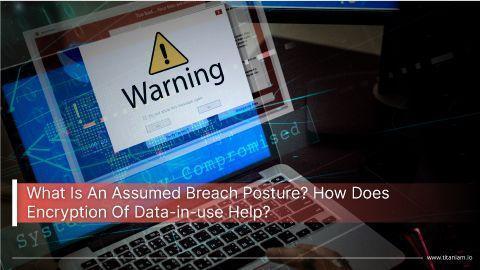Assumed Breach posture: how does encryption of data-in-use help?
 When unauthorized individuals extract restricted and sensitive information from protected systems, the event is known as a data breach. Such incidents incur major financial consequences on the victims. This necessitates a set of standard security measures to be taken.
When unauthorized individuals extract restricted and sensitive information from protected systems, the event is known as a data breach. Such incidents incur major financial consequences on the victims. This necessitates a set of standard security measures to be taken.How can we predict such possibilities and prevent them? Let’s look at Assumed Breach and other tactics to ensure data protection, in brief.
Topmost Prevention Tactics Against Data Breach
- Conduct regular cyber security risk assessments and audits to keep up with the new policies.
- Educate employees on breach of security to avoid the most liable trigger from inducing threat in the security structures.
- Update operating systems and software
- Obtain a Secure Sockets Layer (SSL) accreditation that uses encrypted information and integrated data in the client-server network, to block access to others.
- Have a post-breach blueprint ready to tackle the cyber breach impact on a large scale.
- Back up data daily to restore the operations easily and cost-efficiently in the event of a ransomware attack.
A lot of time is invested in the early phases of the cyber framework which include initial access, execution, preventing persistence of malware, privilege escalation. Yet when people sell access to any system, it’s done post credentials. Therefore it’s important to assume breaches, and deploy defense-in-depth with the help of layered security.
At a time, when data holds more interest than money, taking an Assumed Breach mindset can prevent data compromise from day one.
The Vitamins for your Data System
Building immunity for data protection is very difficult. Ensuring these steps can help secure your systems and networks, mitigating several risks:
- Always do 2FA (Two-factor authentication)
- Never log service account credentials (especially on wiki/JIRA)
- Prevent service account compromise with authentication
- Train staff about phishing
Assuming a Post-Breach Mindset
Data at source, in transit, and in use, must undergo:
- Tokenization/hashing
- Pseudonymization
- Format-preserving encryption (whether data can be masked in use or output)
- Masking in use
- Masking in output
The Largely Ignored Space: Data-in-Use
Cloud puts the entire network at peril. However, the answer lies in encryption of data-in-use where one can rotate the keys, put them in a key vault.
While data is indexed, searched, analyzed, viewed, aggregated, and manipulated by employees or clients, close to 100% of the time, this data-in-use is unencrypted.
A Comprehensive Approach to the ‘Assumed Breach’ Concept
Assumed Breach is an outlook directed towards security investments, design patterns, cyber security vulnerability assessment, and penetration testing. It serves to limit the vested credibility on services, apps, networks, and identities by considering that data is already insecure and compromised.
“Having an assumed breach mindset means thinking about when and, not if we will be breached,” says Ashok Banerjee. He also added, “The key point is that even on the day we are breached, we’re simply breached, not compromised.”
It’s essential to take into account two significant factors namely privacy and security in the assumed breach zero-trust policy. With the intersection of these, the assumed breach mindset helps preserve the integrity of the customers’ data.
The future of cybersecurity is thinking of privacy along with compliance and security and wrapping that into a data security solutions product.
Unravel more information on the Assumed Breach approach and several other state-of-the-art data protection tactics used by experts by visiting our conference page.
Related Resources

Be Prepared to Neutralize Cyberattacks When – Not If – They Happen
Be Prepared to Neutralize Cyberattacks When – Not If – They Happen Businesses today are under the constant threat of cyberattacks from ransomware and extortion.

Boost Cyber Immunity in 2023 by Combating Data Exfiltration
Boost Cyber Immunity in 2023 by Combating Data Exfiltration In recent years, the world has become aware of the effects and nature of a far-reaching

Portal26’s Guide To Preventing Data Exfiltration
Preventing Data Exfiltration Effectively: A Comprehensive Guide In today’s data driven world, data can be considered one of the most valuable assets an enterprise’s possession.
